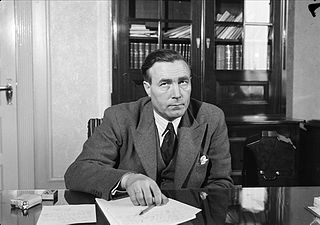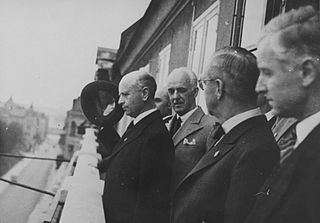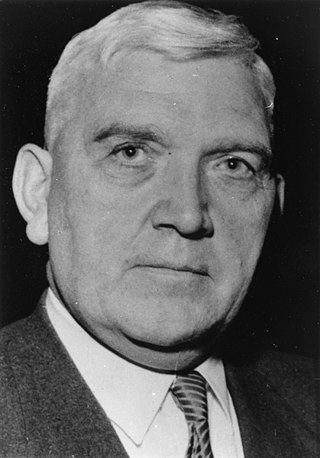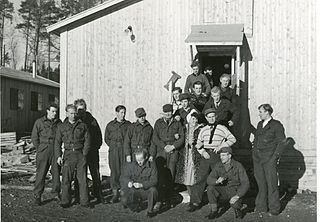Related Research Articles

The Norwegian resistance to the occupation of Norway by Nazi Germany began after Operation Weserübung in 1940 and ended in 1945. It took several forms:
Milorg was the main Norwegian resistance movement during World War II. Resistance work included intelligence gathering, sabotage, supply-missions, raids, espionage, transport of goods imported to the country, release of Norwegian prisoners and escort for citizens fleeing the border to neutral Sweden.

Gunnar Fridtjof Thurmann Sønsteby DSO was a member of the Norwegian resistance movement during the German occupation of Norway in World War II. Known by the nickname "Kjakan" and as "Agent No. 24", he was the most highly decorated citizen in Norway, including being the only person to have been awarded the War Cross with three swords, Norway's highest military decoration.

Jens Christian Hauge was a Norwegian who was leader within the World War II resistance—and one of the two incumbent Milorg Council members in May 1945. He served as Minister of Defence from 1945-1952 and Minister of Justice from January to November 1955.

Kai Christian Middelthon Holst was a Norwegian seaman, fur farmer and resistance fighter during World War II. When the leadership of Milorg was torn up by the Gestapo in 1942, he acquired a leading role in the organisation and participated in re-establishing the central leadership of Milorg together with Jens Christian Hauge. Holst had to flee Norway in the autumn of 1943 and stayed in Sweden until the liberation of Norway in 1945.

Olav Meisdalshagen was a Norwegian politician for the Labour Party best known for serving as the Norwegian Minister of Finance from December 1947 to November 1951 and as the Norwegian Minister of Agriculture from January 1955 to May 1956. He was also a Member of Parliament for a long time, being elected for the first time in parliamentary election of 1936 and serving until his death, except for the period between 1940 and 1945 when the Parliament of Norway was de facto defunct due to the occupation of Norway by Nazi Germany. His death in 1959 came halfway through his fifth term in Parliament, and shortly after a parliamentary speech.
Johannes Sigfred Andersen was a Norwegian resistance fighter during the Second World War, a member of the Norwegian Independent Company 1 (NOR.I.C.1). He was nicknamed "Gulosten"; 'The Yellow Cheese'. He also used the surname Ostein during the war. Andersen was a controversial character, because of his pre-war life as a well-known career criminal and a series of incidents that occurred during the war years. These incidents included Andersen working as an assassin during the war, and shortly after the war killing two German prisoners of war during a drinking binge. After the war, Andersen started a wood furniture business. He was supported financially by King Haakon VII of Norway, whose friendship he had gained during the war. Andersen was repeatedly accused of crimes after the war, and on one occasion convicted.

Jens-Anton Poulsson DSO, was a Norwegian military officer. During World War II he was a Norwegian resistance member, especially noted for his role in the heavy water sabotage 1942–1943. He continued his military career after the war, and was appointed colonel in 1968.
Events in the year 1916 in Norway.
Events in the year 1974 in Norway.

The Norwegian Legation in Stockholm played a significant role during the Second World War. Until 9 April 1940 the legation consisted of four persons, and at the end of the war about 1,100 persons were connected to the legation. Refugee cases were among the legation's most central tasks. In 1941 a military office was established, and this was later split into separate offices for intelligence, and for Milorg related cases.
Ragnar Leif Ulstein MM was a Norwegian journalist, writer and resistance member. He wrote several documentary books from the Second World War, including surveys of the SOE group Norwegian Independent Company 1, volunteers sailing from Norway to Scotland, refugee traffic from Norway to Sweden, and military intelligence in Norway.
Tore Gjelsvik was a Norwegian geologist and polar explorer. He headed the Norwegian Polar Institute from 1960 to 1983, and played an important role in the Norwegian resistance during World War II.

Sven Arntzen was a Norwegian barrister. He was also the acting director general of the Norwegian Prosecuting Authority from 1945 to 1946, and played an important role in the legal purge in Norway after World War II.
Oslogjengen was a sabotage group operating in Oslo from May 1944 to May 1945, during the last year of the occupation of Norway by Nazi Germany. The group had its basis in both the British Special Operations Executive and the Norwegian Milorg, was coordinated by Gunnar Sønsteby, and had around ten members. It was the dominant sabotage group in Oslo between May and September 1944, when they performed a series of successful sabotage operations.
Operation Sunshine was an anti-demolition operation in occupied Norway from October 1944 to May 1945. It was planned by Norwegian military personnel in the United Kingdom in cooperation with British forces, and part of an effort to protect essential installations and industry, in particular large power stations, against destruction in a possible scorched earth action by the Germans towards the end of World War II.
Odd Toralf Øyen was a Norwegian resistance member and anaesthesiological physician.

The Norwegian police troops in Sweden during World War II consisted of around 15,000 men, recruited from Norwegian refugees and trained at a number of secret camps in Sweden.
Arne Semb-Johansson was a Norwegian zoologist. He was born in Kristiania. He chaired the Norwegian Entomological Society from 1950 to 1953. He was assigned as a professor of zoology at the University of Oslo from 1959. Among his early works were studies of the nervous system and endocrine system of insects. He edited the six volume encyclopedia Cappelens Dyreleksikon, published 1979–1981. He was decorated Knight, First Class of the Order of St. Olav in 1987.
Ole Arntzen was a Norwegian businessman and resistance member during World War II. He was a brother of Sven Arntzen. He was a member of the Central Committee of Milorg, where he served as General Inspector from April 1944 to May 1945. His cover name was "Ørnulf". In his World War II memoirs, Gunnar Sønsteby devotes one chapter to the arrest of Milorg leaders Jens Christian Hauge and Arntzen by the State police on 10 April 1945, but their central role was not discovered.
References
- ↑ Moland, Arnfinn (1999). Over grensen? (in Norwegian). Oslo: Orion. p. 88. ISBN 82-458-0337-5.
- ↑ Vold Hurum, Gerd (2006). En kvinne ved navn "Truls" (in Norwegian). Oslo: Wings. p. 117. ISBN 82-992194-0-X.
- 1 2 3 4 Njølstad, Olav (2008). "Problemer med britene". Jens Chr. Hauge – fullt og helt (in Norwegian). Oslo: Aschehoug. pp. 116–119. ISBN 978-82-03-22988-6.
- 1 2 Moland (1999): pp. 60–64
- 1 2 Riste, Olav (1979). "Aksjonar eller beredskap". London-regjeringa. Norge i krigsalliansen 1940-1945 (in Norwegian). Vol. 2. Oslo: Samlaget. p. 33. ISBN 82-521-0954-3.
- ↑ Gjelsvik, Tore (1977). Hjemmefronten (in Norwegian). Oslo: Cappelen. p. 97. ISBN 82-02-03900-2.
- ↑ Bjørnsen, Bjørn. "Johannes Andersen". In Helle, Knut (ed.). Norsk biografisk leksikon (in Norwegian). Oslo: Kunnskapsforlaget. Retrieved 17 January 2010.
- ↑ Gjelsvik (1977): pp. 99-100